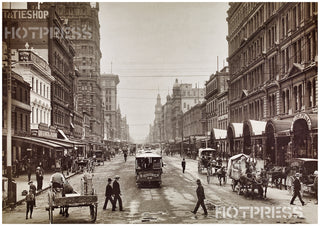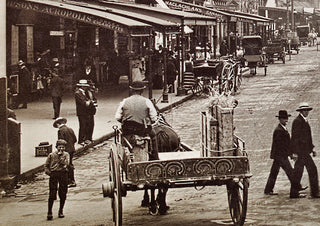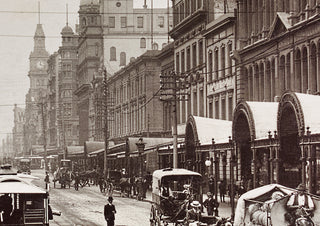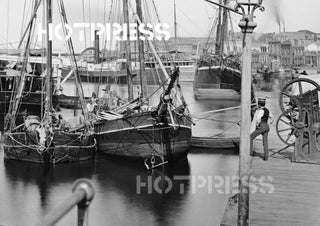1905c Elizabeth Street
Description
A great photo of the southern end of Elizabeth Street around 1905. We're looking north across Flinders Street from a slightly elevated position. A large number of horse and carts are busy moving goods up and down the street; motor cars have not yet found their way to Melbourne.
On the left hand side of the image we see a bluestone building evident in the 1870 Elizabeth Street image. This building was constructed in 1853 and in the 1870 photo housed the Liverpool, London and Globe Insurance Co. By 1900 it was known as Mercantile Chambers building and accommodated a signwriter, someone else who sold bath heaters, and Simpson's Tobacconist, proudly selling Acropolis Greek Cigarettes. Next to him to the north (no signage visible in the photo) is Dentistriades Fruit Shop. Judging by the presence of a fruit barrow in the similar location in the 1870 photo, it seems that a fruiterer has traded in this area for at least a quarter of a century.
Moving north we see Henry B. Hanton's butcher shop on the ground floor (with a butcher in a traditional striped apron standing outside the shop on the edge of the pavement), with Mr Stevens' Fine Art Gallery and F. Pepper doing business upstairs.
Further up the road past Flinders Lane is the towering Australian Building, which was the world's 3rd tallest building when completed in 1889, and for 40 years was Melbourne's tallest building until 1929 (unfortunately this historic building was demolished in 1980). Further along we can see the Melbourne Sports Depot, a Melbourne institution. After that the image is a bit too blurry to see much detail, but the impressive Equitable Building is quite noticeable on the north-west corner of Collins Street.
Looking from the right hand side coming back to Flinders Street, we see the GPO building (with its clock) on the north-east corner of Bourke Street, then Altson's building with its small dome on the north-east corner of Collins Street. The magnificent Royal Bank building (with its slightly larger dome) occupies the south-east corner of Collins Street.
The next building to the right, a three story one, houses Norman Bros Stationers along with F. H. Brunnings Seed Merchants, the forerunner of today's Brunnings garden products. On the southern end of the building we can make out "Australasian Cafe" on the verandah.
South of this cafe and across Flinders Lane is Mrs Burn's Tea-Rooms, then the London Oyster Saloon, nestled next to the "Duke of Rothsay Hotel", and you can just make out the name on the light post displaying the hotel's presence.
Finally, the large building on the right is the home of "Craig Williamson & Co., Drapers and Import Merchants". Also occupying the building towards the southern end are "Lawrence - Dyers". Trading right on the south-east corner of Elizabeth Street is J. Plish, Confectioners to the Victorian Governor (judging by the coat of arms on their cart - See the enlarged image below)). Their small delivery van is parked outside their shop on the far right of the photo.
At the extreme right hand edge we can see a policeman with his white military-style hat. A cart hauling a large delivery of beer barrels is heading south towards Flinders Street. The number 38 Brunswick tram-car has just arrived at the Elizabeth Street terminus.
Of the many impressive street landscapes that have been destroyed in the name of progress, the southern end of Elizabeth Street would win hands down. These beautiful buildings, some of which were the heart and soul of Melbourne are now replaced by some of the ugliest buildings that you could imagine, right up to Collins Street.
All text © HotPress
Photographer unknown.
Notes from the State Library tell us that this image "Shows Brunswick tram and several horse drawn vehicles."
This is a digitally retouched reproduction of the original held by the State Library of Victoria. All prints are reproduced without the HOTPRESS watermarks.
Our team of conservators have worked on a high resolution digital image in order to remove blemishes and artifacts such as stains, mould, scratches and damage caused by the handling of the original. We strive to provide authentic representations of the original work that are suitable for enlargements that retain the tones and character of the original.
Description
A great photo of the southern end of Elizabeth Street around 1905. We're looking north across Flinders Street from a slightly elevated position. A large number of horse and carts are busy moving goods up and down the street; motor cars have not yet found their way to Melbourne.
On the left hand side of the image we see a bluestone building evident in the 1870 Elizabeth Street image. This building was constructed in 1853 and in the 1870 photo housed the Liverpool, London and Globe Insurance Co. By 1900 it was known as Mercantile Chambers building and accommodated a signwriter, someone else who sold bath heaters, and Simpson's Tobacconist, proudly selling Acropolis Greek Cigarettes. Next to him to the north (no signage visible in the photo) is Dentistriades Fruit Shop. Judging by the presence of a fruit barrow in the similar location in the 1870 photo, it seems that a fruiterer has traded in this area for at least a quarter of a century.
Moving north we see Henry B. Hanton's butcher shop on the ground floor (with a butcher in a traditional striped apron standing outside the shop on the edge of the pavement), with Mr Stevens' Fine Art Gallery and F. Pepper doing business upstairs.
Further up the road past Flinders Lane is the towering Australian Building, which was the world's 3rd tallest building when completed in 1889, and for 40 years was Melbourne's tallest building until 1929 (unfortunately this historic building was demolished in 1980). Further along we can see the Melbourne Sports Depot, a Melbourne institution. After that the image is a bit too blurry to see much detail, but the impressive Equitable Building is quite noticeable on the north-west corner of Collins Street.
Looking from the right hand side coming back to Flinders Street, we see the GPO building (with its clock) on the north-east corner of Bourke Street, then Altson's building with its small dome on the north-east corner of Collins Street. The magnificent Royal Bank building (with its slightly larger dome) occupies the south-east corner of Collins Street.
The next building to the right, a three story one, houses Norman Bros Stationers along with F. H. Brunnings Seed Merchants, the forerunner of today's Brunnings garden products. On the southern end of the building we can make out "Australasian Cafe" on the verandah.
South of this cafe and across Flinders Lane is Mrs Burn's Tea-Rooms, then the London Oyster Saloon, nestled next to the "Duke of Rothsay Hotel", and you can just make out the name on the light post displaying the hotel's presence.
Finally, the large building on the right is the home of "Craig Williamson & Co., Drapers and Import Merchants". Also occupying the building towards the southern end are "Lawrence - Dyers". Trading right on the south-east corner of Elizabeth Street is J. Plish, Confectioners to the Victorian Governor (judging by the coat of arms on their cart - See the enlarged image below)). Their small delivery van is parked outside their shop on the far right of the photo.
At the extreme right hand edge we can see a policeman with his white military-style hat. A cart hauling a large delivery of beer barrels is heading south towards Flinders Street. The number 38 Brunswick tram-car has just arrived at the Elizabeth Street terminus.
Of the many impressive street landscapes that have been destroyed in the name of progress, the southern end of Elizabeth Street would win hands down. These beautiful buildings, some of which were the heart and soul of Melbourne are now replaced by some of the ugliest buildings that you could imagine, right up to Collins Street.
All text © HotPress
Photographer unknown.
Notes from the State Library tell us that this image "Shows Brunswick tram and several horse drawn vehicles."
This is a digitally retouched reproduction of the original held by the State Library of Victoria. All prints are reproduced without the HOTPRESS watermarks.
Our team of conservators have worked on a high resolution digital image in order to remove blemishes and artifacts such as stains, mould, scratches and damage caused by the handling of the original. We strive to provide authentic representations of the original work that are suitable for enlargements that retain the tones and character of the original.




